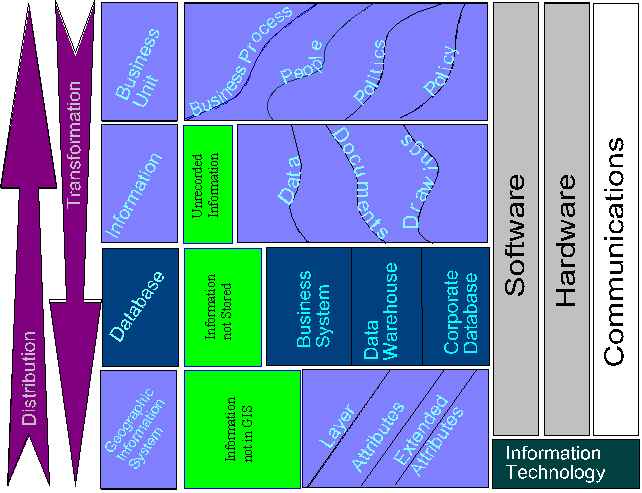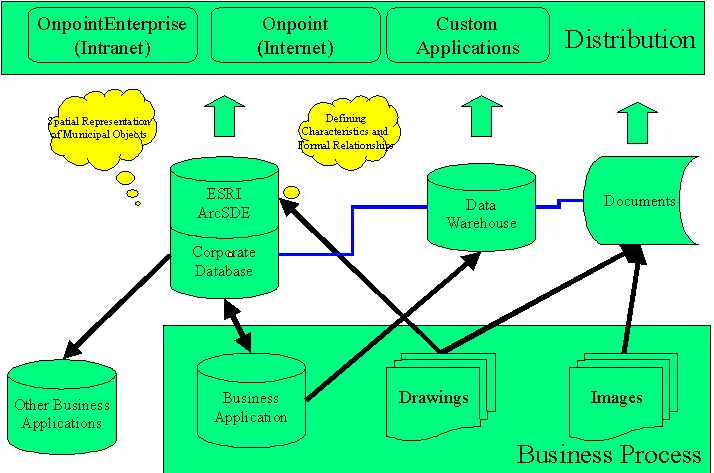
Mike Hausser, P.Eng, B. Eng,
Manager of Database Administration and GIS, City of Kitchener
Presented at
Esri International User Conference 2001
July 10, 2001
San Diego, CA
In the last four years, the City of Kitchener has fastracked implementation of GIS by embracing new technology both in the realm of GIS and traditional tabular business systems. To see the whole picture of an enterprise GIS system the business units of the Enterprise are connected through common identifiers, replication of maintained attributes and statistics, and spatial relationships using database linked maps.
The result is a web-based GIS system connected to a table driven data warehouse that handles all tabular data. A document management component tied to the data warehouse allows direct web access to thousands of related documents. This web-based GIS system Onpoint Enterprise by Orion Technology Inc. is used by several hundred staff with varying computer skills and minimal training. Esri Technology (ArcIMS, SDE) along with Bentley's Microstation, Oracle database, and Cimmetry JView are all utilized in this unique solution.
Technical information regarding the integration of technology and business systems will be presented in conjunction with often more difficult issues regarding Business Process Re-Engineering, 'buy-in', competing priorities and agendas typical of Local Government Agencies.
In any enterprise, information flow between departments is often less than ideal. The fact is that each department has its own purpose and its own priorities. Typically, this does not ensure that others who benefit from information produced as part of a business process are given it on a timely basis. Information that is part of a business process is recorded for historical and administrative purposes and only referred to if there is a problem. People who benefit most from this information are often not involved in the business process and therefore have no direct means of access. This typically creates one or more redundant secondary data collection processes. This takes up valuable staff time, creates multiple manual repositories/references of information, and often leads to errors.
Information that is required to answer a specific question is often found in many different locations, on different computer systems, in different filing systems, and in different departments. This results in significant staff time spent looking for and re-recording information that is available but not effectively organized. Only when all the pieces are put together can one see the bigger picture.
An enterprise can be broken down into layers made up of various components. A model of this is shown in Figure 1.

The first layer is a business unit. An enterprise is made of many business units. Each business unit is driven by business processes that are managed by people. The processes are governed by policy and politics. The business units produce information. Information in the next layer is recorded in the form of electronic data, documents, and drawings. Not all information produced by a business unit is recorded; some information is in the form of verbal communication, and some is practical knowledge retained by staff. Much of the recorded information is stored within databases. These databases are contained within custom business systems, data warehouses, and/or corporate databases. Last but not least is a Geographic Information System. Information in the GIS is stored logically as layers, attributes and extended attributes. As information is produced, recorded, stored, and spatially enabled, it is transformed into an increasingly structured format. As information is transformed there is a conscious decision of what information is to be transformed to the next level and what is not. The decision of what to transform must be made from both a practical and a cost perspective to ensure that a balance is achieved. If too much information is transformed, it may cost more than necessary. If too little information is transformed, then the enterprise is restricting its ability to make use of information that already exists. Each level is supported through the use of software, hardware, and communications that are all part of information technology. Further explanation of the aforementioned terms will be discussed later in this document.
In order to implement a sustainable and complete information flow in the enterprise model, there are many challenges that must be managed. The intent is to manage the challenges and not to solve them. A great deal of effort can be spent on trying to eliminate the challenges; it is often more prudent to manage them through understanding the impact on each piece of the enterprise. In time, some of the challenges will be resolved through active transformation and distribution of information between business units.
Undocumented and disjointed business practices are common challenges which perpetuate the ‘information silo’ concept. This results in multiple recording of the same information into incompatible and independent repositories. This is highlighted by working through an information flow plan for each business unit. This may or may not require business process re-engineering. If information is recorded, transformed, and then re-distributed to other business units in a timely fashion, secondary repositories of the same information will usually stop occurring.
Technology is typically developed much faster than it can be implemented; this may result in features that are missing and made obvious only after the technology is in production for a period of time. New technology may appear to meet the requirements, but generally, it must be proven through full scale testing before limitations are found.
Staff and resource shortages are the usual situation in the industry - either driven by financial constraints, or skill and knowledge constraints.
Customers and staff generally have the idea that technology will solve all their problems and reduce their workload. All too often, resources are withdrawn before it is fully understood what all the changes in skill and staff requirements will be. Implementation of technology does not always imply direct savings in staff or money, but it always means a change in business practice and staff responsibilities and skills.
Business units exist solely to provide a specific service or product. As such, each business unit has priorities that are different than other business units. This pre-determines a communication gap as perspectives and priorities are different. As long as this is known, acceptable solutions to all parties can be achieved through negotiation and communication. A full understanding and acknowledgment of issues for each business unit will generally result in trust and 'buy-in' by all parties.
The majority of people are simply reluctant to change. Change management is an important part of implementing new technology that ultimately will change business practices and processes. Involvement by staff in various levels within each business unit will generally create a receptive environment for change. A sense of ownership must be established with key users.
Information is generated, recorded, transformed, distributed in various forms using differing technologies. This can simply be described as information flow. Figure 2 demonstrates how information flows in the City of Kitchener.

Information recorded in business systems can be replicated into a corporate database that is an Enterprise GeoDatabase. Statistical type information can be extracted from the business systems and posted into the data warehouse. This information is considered to be extended attributes of the corporate database. Information from drawings is converted into GIS layers and attributes in conjunction with identified information from business systems. Drawings can also be indexed against geographic features in order to maintain an online index allowing general access to drawings. Drawings may be scanned from paper copies or may remain in electronic form. Images and documents may also be indexed against geospatial features that will allow online access to documents. Information in the corporate database can be propagated out to other business systems in order to reduce duplicate entry. Information from any of the repositories can be distributed out to others through the use of custom systems or standard tools such as ArcMap.
The corporate database is a geospatially-enabled database commonly known as a GeoDatabase that is a central repository of enterprise objects defined in layers and attributes. Business systems may contribute specific attributes through background replication processes to ensure that the best information possible is available in the corporate database in the most timely manner. In this manner, the corporate database is maintained as a collaborative effort.
The data warehouse is a complementary database to the corporate database. The design used in Kitchener is a flexible, table driven model that enables a wide variety of information to be stored against features defined in the corporate database. Statistics and facts about corporate database features can be extracted from various business processes and stored in the data warehouse. The data warehouse also contains a universal document index that enables a list of documents associated with each corporate database feature. The index can be maintained directly in the data warehouse, or replicated from other business applications.
Distributing information to a large number of users with varying skills is a challenge faced by many organizations. While recognizing that the standard off-the-shelf tools are powerful, they are generally too difficult for the typical staff person to use. A standardized corporate system which has a simple set of functions will not satisfy advanced users or those in the GIS field, but it will satisfy the majority of staff. A web-based Intranet system was designed on these principles. The system was developed by Orion Technology Inc. integrating GIS, database, document viewer, and reporting technologies. This system (now known as OnpointEnterprise TM) with basic tools to query either attributes or extended attributes (or both simultaneously) allows users to find information from any part of the corporation without having to know where or how the information got there. Information is no longer isolated in a business unit or departmental database.
Mike Hausser
Manager of Database Administration and Geographic Information Systems
City of Kitchener
mike.hausser@city.kitchener.on.ca